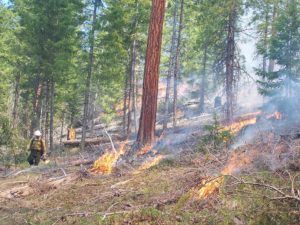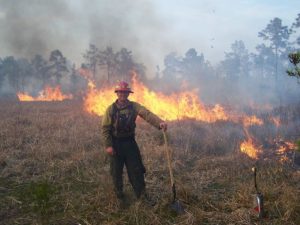Living with Fire

On Friday, May 1, 2015, Jason Llewellyn and Dale Swedberg co-presented about fire ecology and fire history, and shared our region’s story of fire management. Dale Swedberg provided an intro to fire history and fire ecology. Jason Llewellyn discussed what goes into a prescribed fire, from the decision to use fire as a tool, through the planning phase, to carrying out the plan and keeping fire where it is intended. Living in an ecosystem that has been dependent on fires for millennia, we can either tolerate wildfires or support prescribed burning, but it is impossible to have neither.
For a sense what was shared in this event, you can view Jason Llewellyn’s Powerpoint here:
“We all are affected by fire somehow,” Jason said, “and without efforts to use it as a management tool, we are going to continue to see large areas of catastrophic fire that devastate communities and the landscape. We live in a fire dependent ecosystem, so we are only able to deny the land fire for so long.” This event explained how prescribed fires emulate natural conditions, maintaining fire-based ecosystems, and preventing hotter fires that would do more damage than good. As Dale Swedberg said, “Wildfire is a war, prescribed fire is a tool, no fire is not an option!”

Jason Llewellyn has been a primary wildland firefighter for 18 years with the Forest Service. He has worked on prescribed fires in 14 different states ranging from Alaska to Florida, for many different land management agencies including the BLM, National Park Service, Alaskan Fire Service, state land management agencies, private landowners, and the Air force. He has fought fire in 22 different states across the country. He has worked on a diverse base of land management projects in many different capacities. In college he studied Forestry and Wildland Fire Management. Since childhood, Jason has been an avid hunter and fisherman and observer of nature. He has also volunteered on three different fisheries projects in Oregon, Idaho and Montana. When not working with fire somewhere across the country or farming at home, he enjoys pursuing his passion for wild things and wild places.
Dale Swedberg is the Okanogan Lands and Prescribed Burn Program Manager for the state Department of Fish and Wildlife. Since 1976, he has worked for Washington Department of Game, then Washington Department of Wildlife and now Department of Fish and Wildlife. The majority of his career with the agency, in five different positions, has been in Eastern Washington and mostly in North Central Washington. For 16 years, Dale managed the Sinlahekin Wildlife Area (SWA) in north central Okanogan County near Loomis. In this capacity, he enjoyed learning about the plants, animals, their habitats, managing these habitats, the natural and human history. During his tenure, Dale learned that “disturbance” is important in managing habitats. He came to appreciate the fact that many things depend on one or more disturbance regimes and some of these disturbance regimes can be managed for desirable outcomes. Overseeing fire-dependent wildlife habitat that had not seen fire for most of 100 years, Dale observed how the land was deteriorating from being “protected” from fire. Much of his energy and focus was spent on restoring fire with its renewing effects and by-products to the ecosystem, thus restoring functionality.